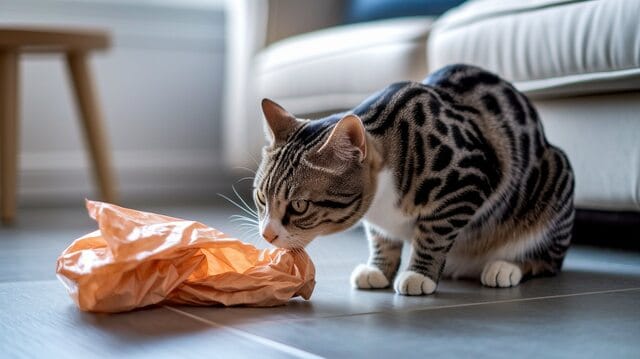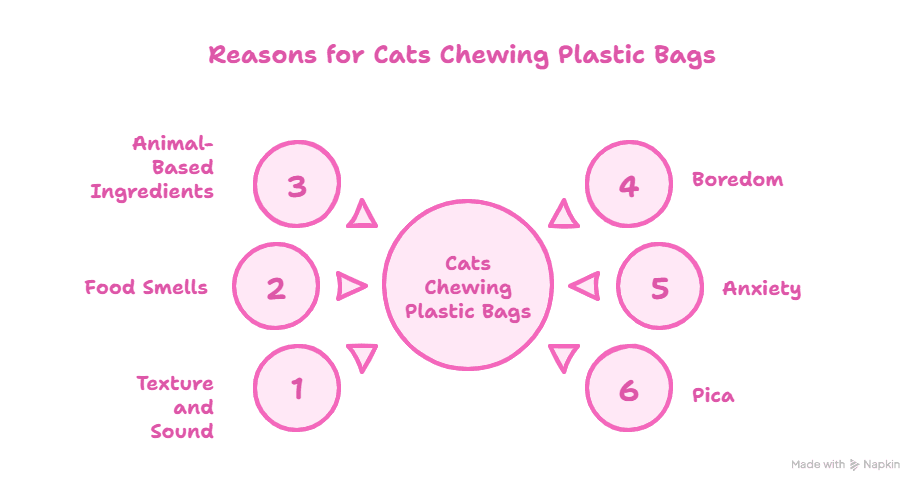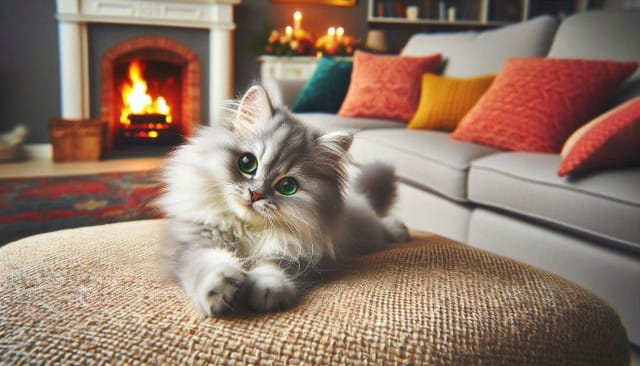
Introduction
You’re putting away groceries or unpacking a delivery, and before you know it—crinkle, crinkle. Your cat has appeared out of nowhere and is chewing or licking the plastic bag like it’s a gourmet treat.
It’s cute, quirky, and… a little concerning.
Why does my cat chew on plastic bags?
If you’ve asked yourself that question, you’re definitely not alone. Many cat owners deal with this strange (and sometimes frustrating) behavior. And while it might seem harmless at first glance, chewing on plastic can actually pose real risks to your cat’s health.
In this article, we’ll explore the reasons behind this odd obsession, whether it’s something to worry about, and how you can safely manage—or even stop—it.
Is It Normal for Cats to Chew Plastic?
Yes—and no.
It’s not rare for cats to show interest in non-food items like plastic bags, straws, or packaging materials. This behavior is common, but that doesn’t necessarily make it normal in the healthy, instinctual sense.
Chewing is a natural feline behavior used for:
– Exploration (especially in kittens)
– Self-soothing
– Play and stimulation
– Dental relief
But when it’s directed at non-edible objects like plastic, it can become problematic, especially if it turns into a habit or leads to ingestion.
Top Reasons Why Cats Chew on Plastic Bags

Let’s break down the most common reasons your cat might be drawn to plastic bags:
🧠 1. Texture and Sound Stimulation
Cats are sensory-driven animals. Plastic bags often have a crinkly texture and sound that stimulates their hunting instincts.
To your cat, the noise might resemble:
– A rustling animal in leaves
– A prey-like scurry
– Something unpredictable and fun to “attack”
In this way, plastic becomes a toy, not a threat.
🍽 2. Food Smells or Residue
If the plastic bag once held groceries—especially meat, fish, or dairy—there might be lingering scents or residue that are practically irresistible to your cat’s powerful nose.
Cats have a sense of smell that’s 14x stronger than humans, so even a trace amount of:
– Chicken grease
– Fish oil
– Bread crumbs or sugar
…can turn a plastic bag into a flavorful chew toy.
🧪 3. Animal-Based Ingredients in the Plastic
Here’s something most people don’t know:
Some biodegradable plastic bags are made with animal-based materials, like:
– Tallow (animal fat)
– Gelatin
– Cornstarch mixed with fats
These ingredients can make the plastic taste or smell appealing to cats—even if there’s no visible residue.
🐾 4. Boredom or Lack of Enrichment
Cats, especially indoor ones, need daily mental and physical stimulation. When they’re bored or under-stimulated, they often develop strange habits—like:
– Over-grooming
– Pacing
– Chewing random household items
Plastic bag chewing might be your cat’s way of saying,
“Hey, I need something to do!”
😿 5. Anxiety or Stress Relief
Chewing can also be a coping mechanism for stress. This may show up as:
– Chewing on plastic, cords, fabric, or wood
– Hiding or excessive grooming
– Nighttime restlessness
Common stress triggers include:
– Moving homes
– Changes in routine
– New pets or family members
– Lack of safe “hiding” spots
Chewing on plastic may provide a sense of control or relief for anxious cats.
⚠️ 6. Pica: Compulsive Non-Food Chewing
Pica is a behavioral disorder in cats where they compulsively chew, lick, or ingest non-food items, often including:
– Plastic
– Fabric
– Wool
– Rubber bands
– Paper
The causes of pica may include:
– Nutritional deficiencies
– Dental pain or discomfort
– Early weaning (in kittens)
– Underlying medical issues
– Anxiety or obsessive-compulsive disorder (OCD)
If your cat is ingesting plastic or other non-edibles regularly, consult your vet—it may be more than just quirky behavior.
Is Plastic Dangerous for Cats?
Yes—plastic bags can be very dangerous to cats, especially if chewing escalates into swallowing.
🚨 Health Risks Include:
🟡 Choking Hazards
Pieces of plastic can lodge in your cat’s throat or block their airways.
🔴 Intestinal Blockages
Swallowed plastic can get stuck in the digestive tract, leading to:
– Vomiting
– Lethargy
– Loss of appetite
– Emergency surgery
🟣 Toxic Exposure
Many plastics contain BPA, dyes, or other chemicals that are toxic if ingested or licked.
🟢 Microabrasions or Cuts
Thin plastic edges can scratch the gums, tongue, or throat—leading to discomfort or infection.
Signs That It’s More Than Just a Habit
If your cat’s interest in plastic is frequent, focused, or intense, it may be time to look deeper.
🚩 Watch for:
– Daily or repetitive chewing
– Chewing plastic over toys or food
– Chewing multiple types of non-food items
– Digestive upset (vomiting, constipation, diarrhea)
– Excessive licking, meowing, or pacing
If you see these, it’s a good idea to consult a vet or feline behaviorist.
How to Stop Your Cat from Chewing Plastic Bags
You don’t have to live in fear of plastic bags—but you do need a prevention plan. Here’s how to curb the habit:
✅ 1. Remove Temptation
– Keep all plastic bags out of reach (drawers, containers, closets)
– Switch to cloth or paper bags if possible
– Never leave grocery bags or packaging unattended
✅ 2. Provide Better Alternatives
Replace the appeal of plastic with safe enrichment options:
– Crinkle toys (sound without danger)
– Cardboard boxes
– Chew-safe catnip toys
– Food puzzles to encourage hunting behavior
✅ 3. Use Deterrent Sprays
Apply a safe, bitter spray to areas your cat targets. Some cats are sensitive to:
– Citrus smells
– Apple cider vinegar
– Commercial pet-safe repellents
Test small areas first to avoid residue or color change.
✅ 4. Boost Daily Stimulation
A tired cat is a well-behaved cat.
– 2 daily interactive play sessions (15–20 mins each)
– Window perches or cat trees
– Scheduled feeding times with puzzle bowls
– Rotate toys weekly for novelty
✅ 5. Address Underlying Stress
If stress or anxiety is driving the behavior:
– Provide hiding spots or cozy nooks
– Use pheromone diffusers like Feliway
– Stick to consistent routines
– Avoid loud noises or sudden changes
When to Talk to Your Vet or a Behaviorist
It’s time to bring in a professional if:
– Your cat is ingesting plastic or other non-foods
– There are signs of GI issues, choking, or weight loss
– Chewing is compulsive and increasing
– You suspect pica or anxiety is at play
Vets may suggest:
– Nutritional changes
– Bloodwork or GI imaging
– Anti-anxiety medication (if needed)
– Referral to a certified feline behaviorist
Safe Alternatives to Plastic Chewing
Instead of letting your cat chew on plastic, try these cat-safe options:
🧸 Catnip Crinkle Toys
– Mimic the sound without the danger
– Infused with catnip or silvervine for extra interest
🪵 Chew Sticks
– Soft, digestible sticks designed for dental health
– Good for cats with oral fixation
📦 DIY Enrichment Options
– Paper bags with holes
– Cardboard treat mazes
– Rolled-up socks stuffed with catnip
FAQs
Why does my cat only chew on certain types of plastic?
Some plastics (like grocery bags or food packaging) contain animal-based oils or carry food residue. Others may have specific textures or scents that your cat finds stimulating.
Is it okay if my cat only licks plastic, not chews it?
Even licking can be risky. Plastics may contain toxins, residue, or dyes, and repeated exposure isn’t healthy. Redirect to safe alternatives when possible.
Will my kitten grow out of plastic chewing?
Some kittens chew while teething and may grow out of it. However, if it becomes habitual or involves ingestion, it should be addressed early to avoid pica.
Also Read - Why Does My Cat Paw at the Mirror? Understanding the Curious Habit
Conclusion
So, why does my cat chew on plastic bags? The reasons vary—from curiosity and boredom to scent, texture, or even underlying stress. While the behavior might seem harmless, it can lead to serious health risks if not addressed.
The good news? With a little prevention, enrichment, and understanding, you can redirect your cat’s obsession with plastic into healthier outlets, keeping them safe, stimulated, and satisfied.
Because when it comes to your cat’s well-being, every little (crinkly) choice matters.




